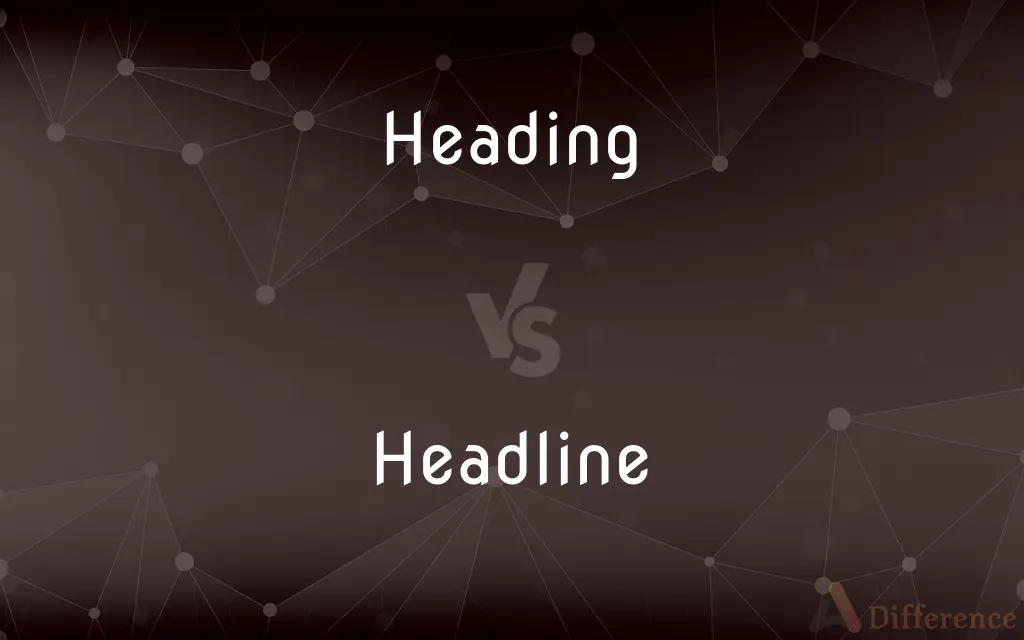Heading vs. Headline — What's the Difference?
By Fiza Rafique & Maham Liaqat — Updated on April 25, 2024
Heading typically denotes the title or a sub-title of a section within a document, guiding readers through a structured content, whereas a headline is a specific type of title that summarizes news articles or captures attention in media.

Difference Between Heading and Headline
Table of Contents
ADVERTISEMENT
Key Differences
Heading serves as a navigational aid within texts, breaking content into manageable sections, while headline is crafted to be eye-catching and informative, often used in newspapers and online articles to draw readers in.
Headings are often more functional, guiding readers to different parts of a document or website, whereas headlines are primarily designed to be impactful and summarize the main point of an article.
In formatting, headings can be hierarchical, including various levels like H1, H2, H3 in documents, on the other hand, headlines usually appear at the top of articles or pages without a hierarchical structure.
Headings may appear in any form of written material, including books, reports, and websites, whereas headlines are almost exclusively found in journalistic contexts, such as newspapers and news websites.
The style of headings can vary widely depending on the document type and design, while headlines often follow specific journalistic styles, aiming to convey urgency or intrigue.
ADVERTISEMENT
Comparison Chart
Purpose
Organizes content within a text
Captures attention, summarizes news
Context
Books, websites, academic papers
Newspapers, online news articles
Format
Hierarchical levels (H1, H2, etc.)
Usually one main line
Style Variation
Depends on document or website
Consistent with journalistic standards
Typical Placement
Throughout the document
At the beginning of articles
Compare with Definitions
Heading
Subtitle under a main title used to divide sections in a text.
Under the heading Materials, the article lists all necessary supplies.
Headline
The title of a news article, designed to summarize the story and attract readers.
The newspaper featured the headline Mayor Announces New Policy.
Heading
A navigational feature in digital documents or websites.
Each heading on the website was linked to a different section of the page.
Headline
A phrase at the top of a feature article in magazines or online platforms.
The headline Secrets of a Happy Marriage topped the magazine's monthly feature.
Heading
A term used in SEO to describe text on a website that is marked with H1, H2, etc.
The main heading used the H1 tag for better SEO performance.
Headline
Used in advertising to convey the main message in a bold manner.
The ad’s headline read Sale Ends Tomorrow!
Heading
Title at the top of a page or section of a document.
The chapter starts with the heading Introduction.
Headline
In journalism, often includes puns or alliteration to grab attention.
Fur Flies as City Debates Cat Leash Law was a clever headline in the local paper.
Heading
Label used in a form or any document to signify the start of different content.
The budget report was organized under several headings.
Headline
Brief, to the point, and often sensational to draw immediate reader interest.
Shocking Turn of Events was the headline after the unexpected election results.
Heading
A title at the head of a page or section of a book
Chapter headings
Headline
The headline or heading is the text indicating the nature of the article below it. The large type front page headline did not come into use until the late 19th century when increased competition between newspapers led to the use of attention-getting headlines.
Heading
A direction or bearing
He crawled on a heading of 90 degrees until he came to the track
Headline
The title or heading of an article, especially in a newspaper, usually set in large type.
Heading
A horizontal passage made in preparation for building a tunnel.
Headline
Often headlines An important or sensational piece of news.
Heading
A strip of cloth at the top of a curtain above the hooks or wire by which it is suspended.
Headline
A line at the head of a page or passage giving information such as the title, author, and page number.
Heading
The title, subtitle, or topic that stands at the top or beginning, as of a paragraph, letter, or chapter.
Headline
To supply (a page or passage) with a headline.
Heading
The course or direction in which a ship or aircraft is pointing or moving.
Headline
To present or promote as a headliner
The Palace Theater headlines a magician.
Heading
A gallery or drift in a mine.
Headline
To serve as the headliner of
He headlines the bill.
Heading
The end of a gallery or drift.
Headline
(journalism) The heading or title of a magazine or newspaper article.
The headline on today's newspaper reads "John Doe Wins Wood-Splitting Competition."
Heading
Present participle of head
Headline
The line at the top of a page containing the folio or number of the page.
Heading
The title or topic of a document, article, chapter, or of a section thereof.
Put the information under the "Advantages" heading
Headline
(entertainment) The top-billed attraction.
Heading
(nautical) The direction into which a seagoing or airborne vessel's bow is pointing (apparent heading) and/or the direction into which it is actually moving relative to the ground (true heading)
Headline
(nautical) A headrope.
Heading
Material for the heads of casks, barrels, etc.
Headline
To give a headline to a page or section of a text.
Heading
(mining) A gallery, drift, or adit in a mine; also, the end of a drift or gallery; the vein above a drift.
Headline
To present as the main attraction; to have top billing, to be the main attraction.
Heading
(sewing) The extension of a line ruffling above the line of stitch.
Headline
The line at the head or top of a page.
Heading
(masonry) The end of a stone or brick which is presented outward.
Headline
See Headrope.
Heading
(flags) A strip of material at the hoist end of a flag, used for attaching the flag to its halyard.
Headline
A title for an article in a newspaper, sometimes one line, sometimes more, set in larger and bolder type than the body of the article and indicating the subject matter or content of the article.
Heading
The act or state of one who, or that which, heads; formation of a head.
Headline
A similar title at the top of the newspaper indicating the most important story of the day; also, a title for an illustration or picture.
Heading
That which stands at the head; title; as, the heading of a paper.
Headline
To mention in a headline.
Heading
Material for the heads of casks, barrels, etc.
Headline
To furnish with a headline (senses 1, 3, or 4).
Heading
A gallery, drift, or adit in a mine; the vein above a drift.
Headline
To publicise prominently in an advertisement.
Heading
The extension of a line ruffling above the line of stitch.
Headline
The heading or caption of a newspaper article
Heading
That end of a stone or brick which is presented outward.
Headline
Publicize widely or highly, as if with a headline
Heading
A line of text serving to indicate what the passage below it is about;
The heading seemed to have little to do with the text
Headline
Provide (a newspaper page or a story) with a headline
Heading
The direction or path along which something moves or along which it lies
Heading
A horizontal (or nearly horizontal) passageway in a mine;
They dug a drift parallel with the vein
Common Curiosities
Where are headlines commonly found?
Headlines are typically found in newspapers, magazines, and online news platforms, aiming to quickly inform readers about news or articles.
How do headings differ from headlines in purpose?
Headings are meant to structure and organize content for clarity, while headlines aim to attract attention and summarize a story compellingly.
What is a heading?
A heading is a title at the top of a page or section within a document that gives a brief idea of the content that follows.
How do headings affect the readability of a document?
Headings improve the readability by breaking up text into manageable sections, making it easier for readers to follow and understand the material.
Where are headings commonly used?
Headings are commonly used in academic papers, books, and reports to organize content and make it easier to navigate through different sections.
What impact do headlines have on reader engagement?
Effective headlines can significantly increase reader engagement by enticing them to read the article or news story based on its perceived relevance or interest.
Are headings typically longer or shorter than headlines?
Headings can vary in length but are typically more straightforward and descriptive, whereas headlines are usually crafted to be brief and impactful.
What is a headline?
A headline is a brief title at the top of an article or news story, designed to grab the reader's attention and summarize the main point of the content.
What stylistic features are common in headlines?
Headlines often use active verbs, present tense, and can include stylistic devices like puns, alliteration, or ellipses for impact.
Can headings and headlines be interchangeable?
Generally, headings and headlines serve different purposes and contexts, so they are not interchangeable; headings organize, headlines attract.
Share Your Discovery

Previous Comparison
Ledger vs. Leger
Next Comparison
Consolidated vs. NonconsolidatedAuthor Spotlight
Written by
Fiza RafiqueFiza Rafique is a skilled content writer at AskDifference.com, where she meticulously refines and enhances written pieces. Drawing from her vast editorial expertise, Fiza ensures clarity, accuracy, and precision in every article. Passionate about language, she continually seeks to elevate the quality of content for readers worldwide.
Co-written by
Maham Liaqat















































